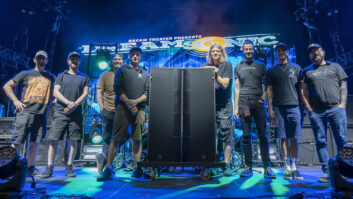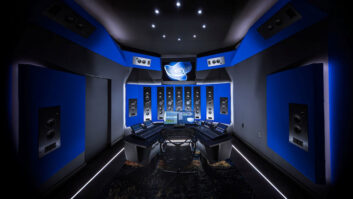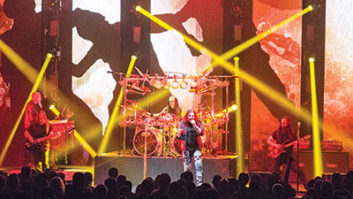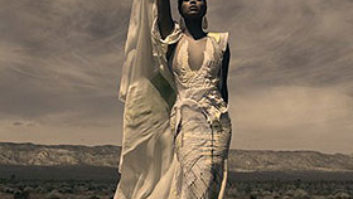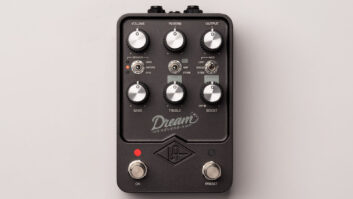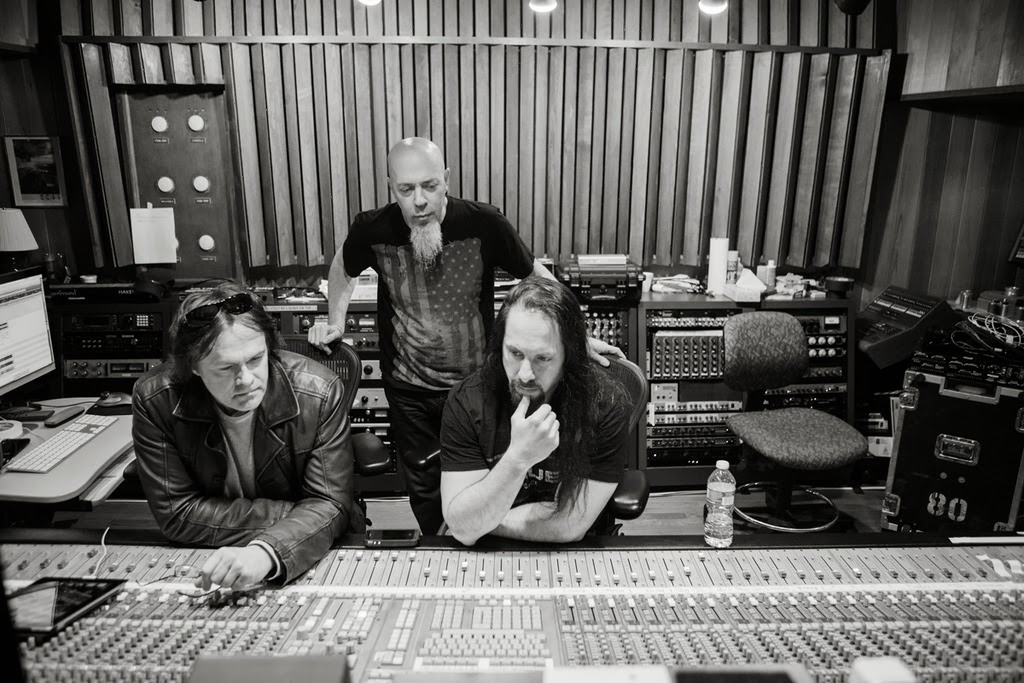
For more than 30 years, Dream Theater has remained true to their roots: inspired progressive metal. Their new album, Distance Over Time, is certainly evidence of that. But it was the band’s 2016 two-disc rock opera, The Astonishing, that pushed the group and engineer Richard Chycki to the limit in terms of the complexity of both the album’s compositions and in its sophisticated, creative recording process.
Founding member John Petrucci, the band’s virtuoso guitarist, began developing the project in the summer of 2013. “I wanted this to be a multi-leveled endeavor,” he says. “I wanted it to be a live show with two acts; long enough to be the length of an opera or a musical. So there had to be two hours of music. And that meant I needed a deep, rich story with multiple levels, in order to write that much music around it.”
A huge fan of Games of Thrones, Star Wars and the writings of Tolkien, but also immersed in music, Petrucci wanted a story centered on music, but filled with themes, characters and places, much like musicals such as Les Miserables and Jesus Christ Superstar.
“I started looking at how a lot of things people used to do are now automated,” he recalls. “I started thinking, ‘With all the technology in music recording, different instruments and apps, what if it went to the point where computers and machines could make music, but that it backfired to where they were the only things that made music? That people wouldn’t feel the need to do it themselves and lost the drive to do it. So my world, about 300 years from now, was a dystopian future where music is not something that is expressed by people, and only made by these machines.”
Said machines are the NOMACS (Noise Machines), which float about the world menacingly, generating strange, non-musical sounds. Fighting to return humanity to the forbidden creation of music is Gabriel, a savior-like character who helps those who lead the rebellion against nasty ruler Nafaryus—whose daughter, Faythe, happens to find herself in love with Gabriel. “Gabriel is the chosen one in the story who was meant to restore artistic expression and freedom into this world, which he does.”
Beginning in the summer of 2013, and continuing for about year, Petrucci dove into writing the story in detail, redrafting it several times, before finally solidifying it during the Masters of Rock Festival in the Czech Republic in July 2014. He then presented it to the rest of the band. “I kind of laid out everything the way I saw it, as a standalone show, presented like The Wall, with visuals and no other Dream Theater songs and no encores,” he says.
He and keyboard master Jordan Rudess would write the music, and then it would be recorded not in the usual fashion, with everyone in one studio, but piece by piece, and with a real orchestra and choirs. “It was a lot for everyone to swallow,” Petrucci recalls. “But the entire band went, ‘Yeah, go for it. This is awesome, we love it. We’re onboard.’ That was a sigh of relief.”
Being new to the art of musicals, Petrucci studied Les Miz and Superstar to learn how their writers/composers would take themes and make them reappear, associated with specific characters and events within the story. “You’ll hear them disguised as different instruments, which is something you see in movies all the time,” says Chycki, the engineer. “I’m listening, going, ‘Oh, wow. There’s that really heavy-duty metal riff, but it’s the orchestra playing it.’ You don’t hear it at first, but when it clicks in, you see all these interacting pieces.”
Petrucci and Rudess began in earnest in November 2014, immediately following the Halloween end of the band’s Along for the Ride tour, each working separately in their home studios—Petrucci in his basement on his iPhone, Rudess with a more standard studio setup, recording to Logic.
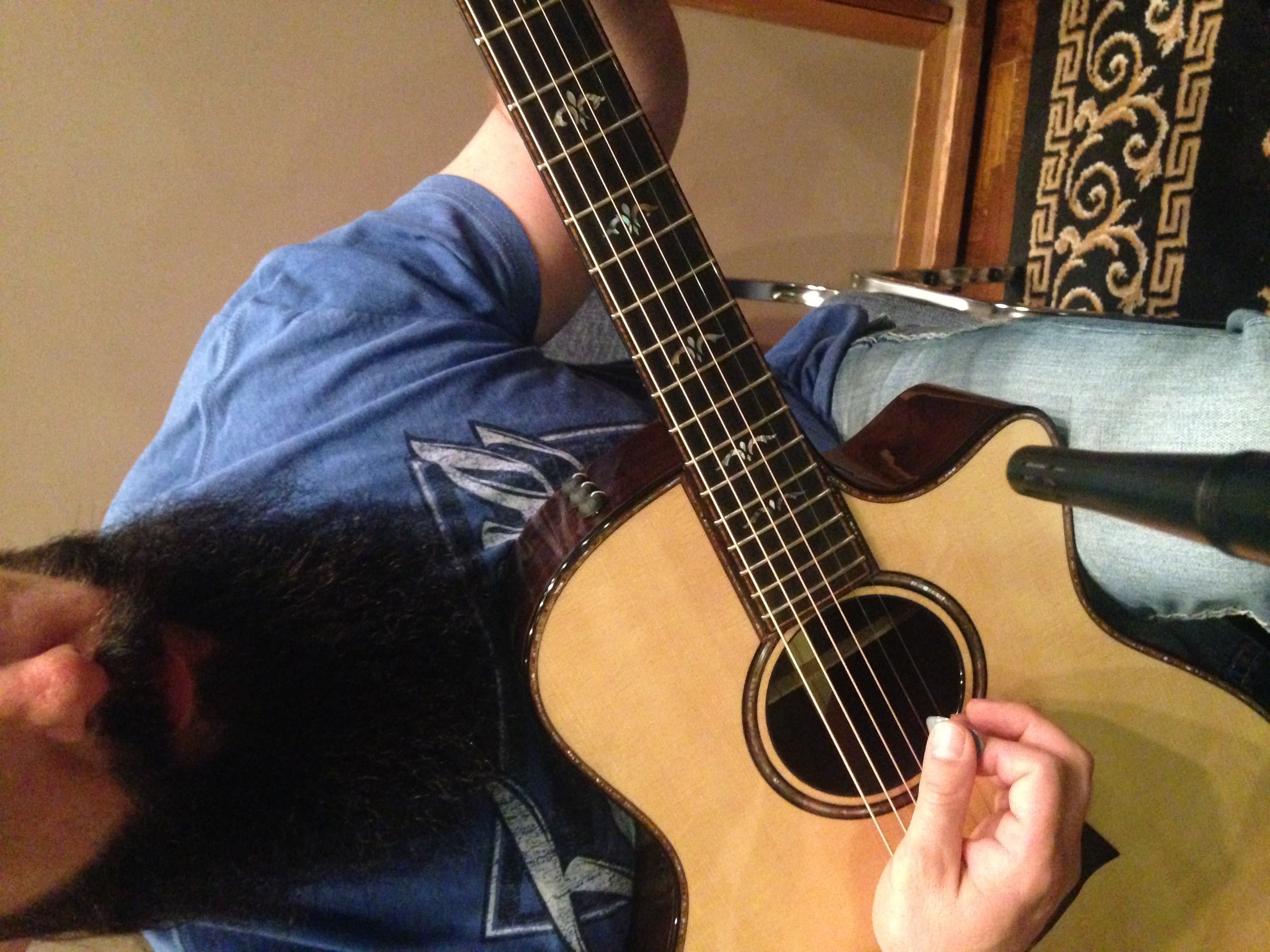
“Jordan is such an incredible writing partner,” Petrucci, a Berklee College of Music graduate, says of his Juilliard-trained writing partner. “He’s so creative and can improvise on the spot, anything. I could describe the mood, and he just starts playing and it’s gorgeous. His wealth of musical knowledge and ability on the piano and keyboards is mind-blowing. It’s literally like having a human music scoring computer sitting next to you.”
The process continued that way until February 2015, when it was decided writing together in the same place might be even more productive. The pair moved into Cove City Sound Studios in Glen Cove, NY, near the homes of both Petrucci and Rudess.
Owned by Richie Cannata, Billy Joel’s original saxophonist, the studio had previously hosted Dream Theater for recording the band’s Train of Thought (2003), A Dramatic Turn of Events (2011) and Dream Theater (2013). “I’m a Long Islander; there aren’t a lot of studios out here, but Cove City is one of the big famous ones,” Petrucci notes. “We could move everything in there and basically live there for a half a year.” Adds Chycki, “There’s good resources in the area—everything from hotels, restaurants…everything at our disposal. It’s a good place to make a record.
“It’s all wood, with very tall ceilings, very diffused,” Chycki adds. The control room features an SSL 4064 G+ mixing console, with its former desk, a 32-channel Neve 8068, available in the live room. Chycki ended up using the Neve for submixing during recording: “There’s 32 channels of mic pre’s there, so when I was tracking, I would start by filling up the Neve with inputs. It’s like a giant sidecar for tracking.”
Chycki had been working with Rush since 2004, a band Dream Theater was heavily influenced by. He and Dream Theater’s versatile lead singer, James Labrie, had been in a band together in Canada when they were younger, and Labrie suggested him for recording the singer’s vocals, at Chycki’s studio in Toronto, for A Dramatic Turn of Events (tracked by the band’s previous engineer, Paul Northfield). “That was an album I felt was important for James to have a great vocal recording experience,” Petrucci recalls. “And I thought it would be great if he was to record with his buddy, Rich, with whom he has so much history in Canada.
“And after that, we started using Rich for mixing our live recordings,” he continues. “We felt, ‘Well, he’s a really brilliant engineer, maybe we should bring him to actually engineer the album.’ We clicked. He’s hysterically funny and has a wealth of knowledge, as far as gear and technical issues. He’s just a complete wizard. He has a brilliant ear for EQ and sounds. And he has the patience and wherewithal to sit there with us, from inception to creation, tracking every instrument, all the way through the mix. On this album, we went through all four seasons, and Rich was there the whole time. He’s intimately more familiar than any of us with the whole album.”
Notes Chycki, “I enjoy the complexity of the process. This wasn’t a case of an artist saying, ‘Here’s an 1/8-inch mini from my laptop, let’s rock.’ I get to exercise my ears, and I get to exercise my mind, with a project of this magnitude.”
Once at The Cove, Petrucci, Rudess and Chycki (along with the band’s assistant engineer, James “Jimmy T” Meslin and guitar tech Matt “Maddi” Schieferstein), finished writing each piece and tracked fully fleshed out demos. “We literally wrote every single song on the album, demoed them fully, with click tracks and markers,” Petrucci explains. “There was mock orchestration by Jordan—guitar, piano, everything. So when we presented them to the band, and to [orchestral arranger] David Campbell, they had full, complete songs.”
“Everything was classified as ‘demo tracking,’ but we ended up keeping some of the demo pieces for the record,” Chycki explains. “There were particular segments where both John and Jordan were happy with what they did, and we kept them.” Notes Petrucci: “Every once in a while, there’d be something that I played, a solo or something [such as that for “Our New World”], where I’m like, ‘You know what” I don’t think it’s gonna get any better. So why don’t we just keep that for the album.’ The same for some of Jordan’s synth lines.”
Demo work continued until the beginning of April, around Easter, and, after a few days’ break, tracking for the album began in earnest. Chycki began by first transferring the demo session files—audio and MIDI, which were recorded in Logic—to Pro Tools.
Drums and Guitar
The recording process began with drummer Mike Mangini, who played to the demo material on each track, mostly recording in continuity to help him stay within the emotional turns of the story. His work was broken into two groups of sessions, with the second round coming after guitar and keyboard overdubs were completed on some tracks.
The technically versatile Mangini, playing on a massive kit—two kicks, snare, eight tom toms (arranged in “orchestra fashion,” in an inverted V), four Octobans above, and LOTS of cymbals—developed his parts without the presence of any vocal or melody line on the recordings; they hadn’t been written yet.
“He was literally just playing to a demo and a click,” says Petrucci, still astonished (pun intended). “And he came up with all these parts. He instinctually placed his fills and different feels in the perfect spots, where, once the vocals were recorded, it just sounded like he had listened to the vocals, but he hadn’t.”
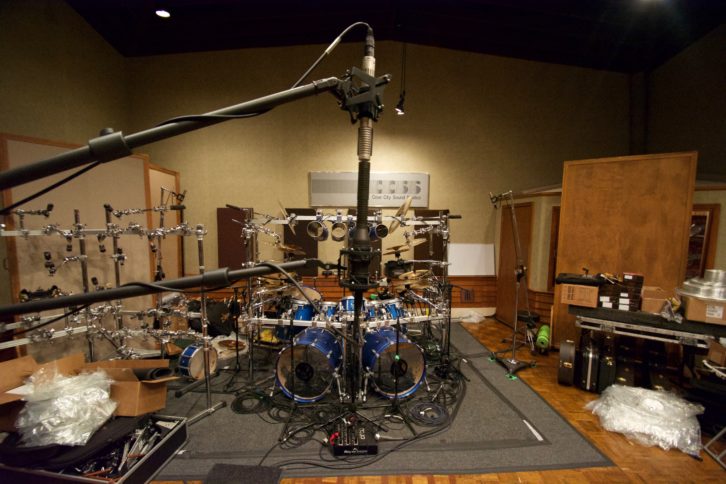
Chycki tracked Mangini’s massive kit to 42 inputs (something he was quite used to after recording Neil Peart for Rush, who typically would require more than 40 inputs). Only 30 of those, though, were for microphones, the rest from MIDI inputs. The engineer would pass as many as possible through the Neve 8068—“All the critical parts of his kit, where I want it to be nice and snappy and have the Neve ‘rock sound,’” Chycki notes.
Each kick took a Shure Beta 91 and an AKG D112, the latter right at the hole in the rear skin, the 91 right on top of the muting material behind the skin. For snares, a number of mics were used: on one, a Mojave Audio MA-101 FET condenser and a Shure SM57 on top, with an AKG 414 on the bottom, to capture the sizzle of the snare chains; and on the second, smaller snare, just the 57 and 414.
Octobans were miked with a set of Shure Beta 98s, a small cardioid condenser with a gooseneck, “due to the limited real estate,” Chycki says. “We have a lot of mics to fit in around him and keep everything out of strike zones.” The same mics are used on the first seven of the tom toms, the eighth getting a Shure Beta 52. “That’s a large, very chunky capsule mic that we used to capture the low end of Tom 8, which is essentially the same size as a kick drum.”
The main overheads were Royer R-121s, and for Mangini’s clusters of cymbals, Chycki used DPA 4006s as fills to get right in the center of all the clusters. Hi-hats were covered by Neumann KM-184s.
Chycki would use Royers for all of the room mics, a pair of tube SF-24Vs for the main room sound, set up in a Blumlein configuration with a single Royer 122V underneath, placed eight feet in front of the kit. “That allowed us to have a lot of room sound, and then be able to control the mono element of it separately,” he says. “Adding just a bit of the 122 mono element really adds a lot of projection to the snare and kicks.” An additional U47 FET was placed behind Mangini, down low, to pick up the bottom end from the kick drums.
On the record, listeners will also pick up a unique “clicking” sound heard in the drum mix. The clicks are created by trigger pads placed on Mangini’s kicks and snares, which were connected to a tiny Roland TM-2 trigger module, which was used to generate an extra tick for the upper register of the kick. The drummer also used a Redbox percussion synth for various elements. The TM-2 module also sends a MIDI signal out, which Chycki records.
Though both are recorded, only the MIDI info from the Roland TM-2 was used, mainly to trigger whatever samples were deemed appropriate for whatever song the sounds would appear in—most often a click added atop the actual drum hits.
Says Petrucci, “Mike’s kick drum playing is some of the best in the world. It’s so precise. So we wanted to make sure that we brought that clarity out. So besides having the fullness of the kick drum, we have the clarity with the click to bring out those lines. And that’s especially important when you have the 7-string guitar playing heavy riffs, with a lot of locked-in rhythms, where we’re all technically playing the same time. The click on the kick drum brings out that metal side and makes it sound more technically glued and technically precise—and heavier. It’s not a mellow sound.”
Once the drums were completed, Petrucci recorded his rhythm guitar parts (with solos coming after Rudess recorded his keyboards). For guitars, Petrucci typically hauls in an arsenal of his favorite Music Man Signature guitars and Mesa Boogie amps. He decided to focus the sound for this project on 6- and 7-string (mostly the latter) Majesty Artisan models, a version of the all-African mahogany guitar the manufacturer makes in his Signature line.
For amplification, he used a prototype signature amp Boogie was developing with Petrucci, based on the treasured Boogie Mark IIC+ and appropriately named the JP-2C. “The IIC+ is the holy grail of Boogies that was popular in the 1980s,” he notes.
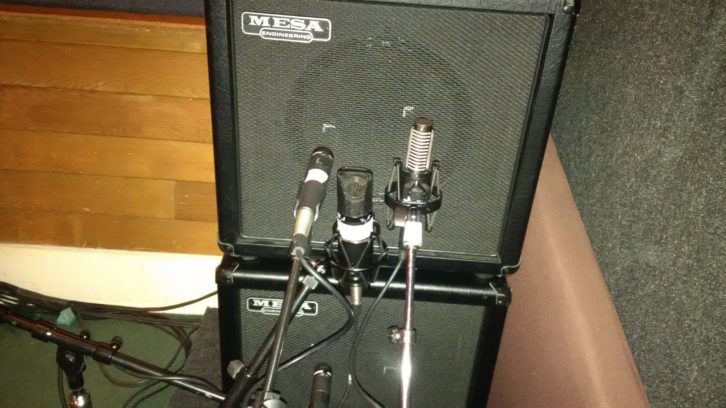
The cabinet was placed in what Chycki refers to as a “guitar condom.” “Cove has a good-sized iso room where we recorded John, so we would place bales of Roxul insulation [in there]—the same as you find in the walls of most studios. We would mike up John’s guitar properly, and then put all these bales around the cabinets—top, front, everywhere around—so we’re essentially creating an anechoic chamber with his guitar. So when he does any tight rhythms, there isn’t any leftover reverberation; there’s no release in the room. It’s very, very tight.”
Chycki miked Petrucci with a combination of Royer 121, Mojave FET 301 and a little bit of Shure SM57, placed at the center of the cone for additional brightness. “I’ve been using Royer 121s since I worked with Aerosmith in 1999-2000, and I’ve been using them since. That’s been a no-brainer. And the 301 was just mind-blowing on his guitar, with no EQ. So we had those three on a 1×12, as well as on a 4×12.”
Those parts went into Neve 1073 mic preamps, before being submixed and recorded to Pro Tools. “Those would be mixed to mono on the SSL, with no EQ, and then John would double-track,” Chycki says. “And we’d also record John with a DI, just so we can use the visible transients, for any small housecleaning we may need to do after the fact.”
Because of the storytelling nature of the album, acoustic guitar is featured moreso than on any other Dream Theater album to date. Petrucci’s instrument of choice, as always, was a Taylor, in this case a new Taylor 916ce. On the demos Petrucci made use of the 916ce’s onboard pickup; for the actual tracking, Chycki used an Earthworks SR40 40 Hz high-definition cardioid mic, also tracking the pickup as a DI input. “We did record DI, but I really enjoyed the sound of that Taylor, to hear the sound of the wood, which is just wonderful,” Chycki says.
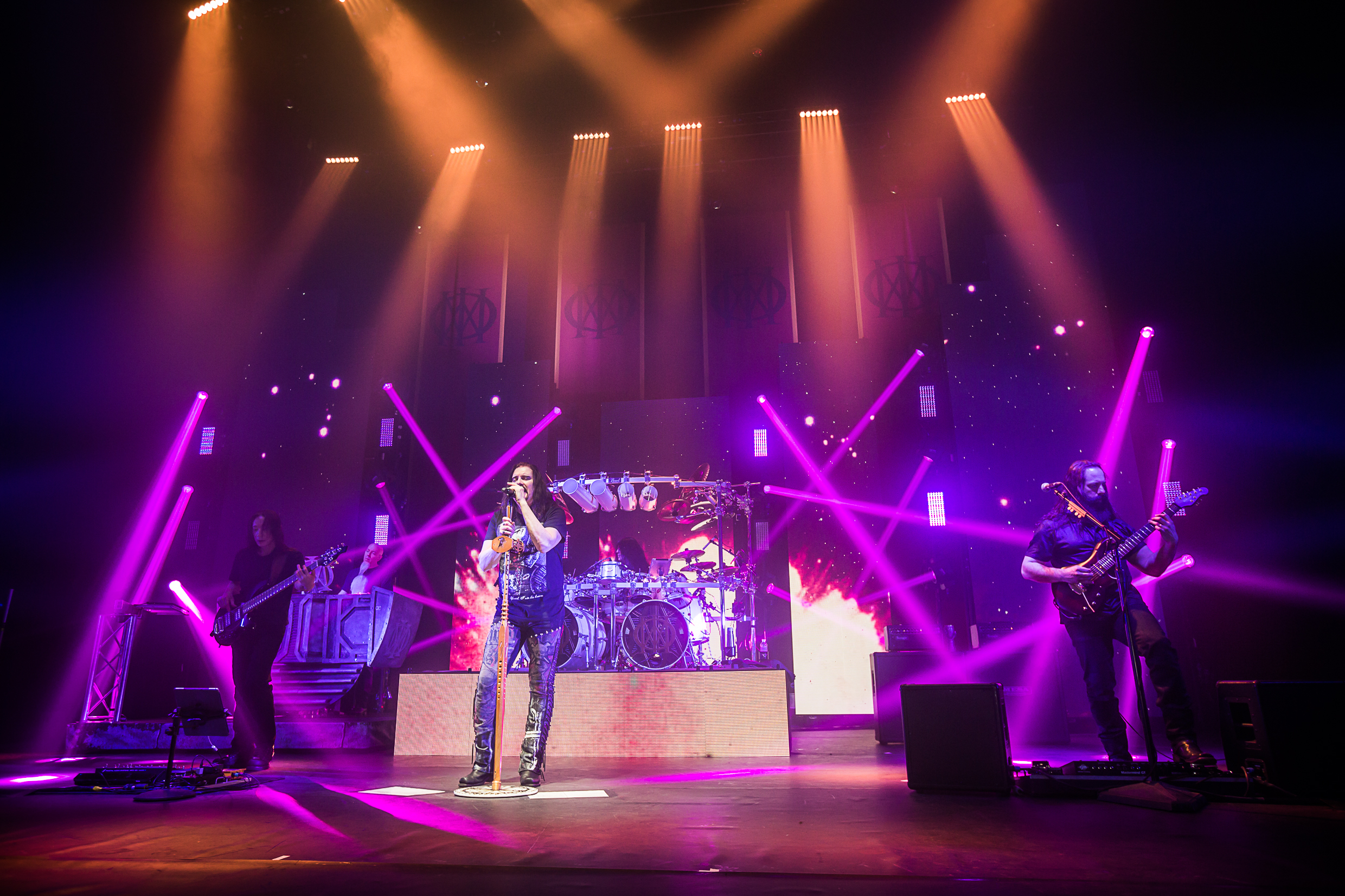
Keys, Piano and Bass
Rudess’ keyboards were recorded next, with his synths nearly always via S/PDIF or AES3 directly into Pro Tools. “We actually would just track MIDI,” Chycki explains. “He would do the performance live, and we would just record the MIDI. And that would allow him to change or adjust individual notes or any other small changes if he wished.”
For piano parts, though, Petrucci wanted to stay away from synths. “Because there was going to be a real orchestra and real choir, I wanted to make sure we recorded real piano and real organ,” the producer states. Rudess found a studio in Astoria, Queens, by the name of The Samurai Hotel, which had a 10-foot Steinway Grand and a Hammond B3 with a Leslie cabinet.
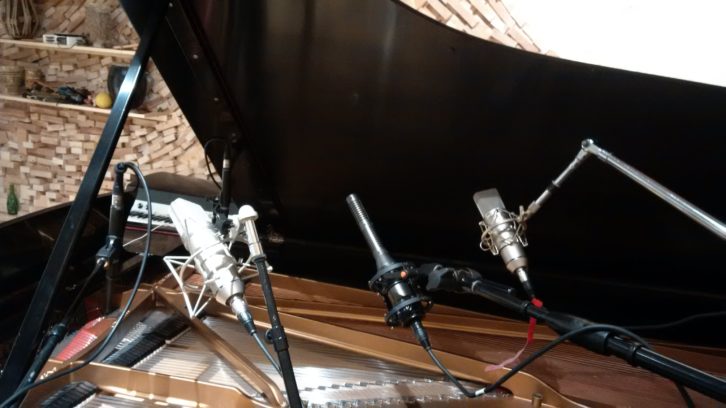
“We went in with Rich for a week and Jordan recorded all of the piano—and there’s a ton,” Petrucci says. “Just like in musicals, in theater and in opera, the piano carries a lot of the themes. Jordan is playing that role.”
Chycki recorded the piano with a Royer SF-24V ribbon mic to capture the room and a pair of Neumann U87s and a pair of Earthworks SR40 mics near the hammers. “It’s mostly the SF-24V, and dialing in the brightness using the SR40s so we can get the transients.” The Hammond’s Leslie received a pair of Royer R-121s at the horn, with a single Sennheiser 421 on the drum.
The final instrument to be tracked was John Myung’s bass, which took place (along with final guitar solos) after a brief tour. By this time, guitar lines were completed, as were Rudess’ demo tracks for orchestra and piano. Chycki recorded Myung’s bass via three different audio chains, onto three separate tracks. The bass signal was split to both a DI (via a Tube-Tech MP-1 preamp and Tube-Tech CL 1B Opto compressor) and to his Mesa Boogie Bass 400 amp.
“That’s a behemoth, rack-mountable tube head,” the engineer explains. “It had a dozen Mesa Boogie 6L6 STR 400 tubes in the power amp section with massive output and power transformers. So it sounded great, and it was heavy enough that, if there was ever a hurricane, it would hold the building down,” he laughs.
That was output to a pair of Mesa cabinets, a 4×10 and a 4×12. Both were miked with Shure Beta 52s to the SSL desk, the 4×10 then compressed with a UA 1176. The 4×12 signal passed through a Little Labs Voice of God Bass Resonance processor to increase the bottom end and the two were summed through a Summit Audio TLA-100 Tube Leveling Amp before going to Pro Tools.
Another split took the bass signal through a Suncoast preamp, into a Matrix power amp and out through another Boogie 4×12, miked and then fed into another channel, making the third bass channel.
One last instrument had to be recorded, accomplished at the very end of tracking: the sound of the NOMACS. “In my mind, the ‘music’ coming from the NOMACS had to be heartless, mechanical, not very musical, crappy music that the people just had to endure,” Petrucci explains. “So we decided we’d make it really mostly electronic-based, to make it very avant garde and weird. Jordan is like a human computer sitting next to you. He came up with those on his own at home, and he’d send them to me, and they would be the basis of what we’d build upon.”
Astonishing Orchestra
Arranger David Campbell was brought in to help being the cinematic edge, having arranged countless feature film scores, as well as worked with recording artists ranging from Josh Groban to U2 and Rush. “He was brilliant, not only because we had orchestra and different types of choirs, but other specialty instruments,” Petrucci says, mentioning a military marching band, mandolins, fiddle and bagpipes. “Every time we’d bring up an instrument, David would say, ‘I know the perfect guy.’ And he was also very sensitive to make sure that Dream Theater sounded like a rock band, and it wasn’t just a symphonic recording.”
Campbell received the Pro Tools sessions, complete with Rudess’s MIDI synth mockups, early in 2015, while the band was still tracking at Cove City, and they were tidied up by music editor Brandon Williams. Rudess’ mockups were, in themselves, quite elaborate.
“Jordan is classically trained, and is very, very strong with composition and instrumental,” Chycki states. “He’s a great keyboard player, but has an instinctual understanding of the response of a standup bass or a harp or a tuba. He doesn’t write them as keyboard parts, per se, he writes them as how those instruments would be played. And then it was just up to David to refine those parts and flesh them out.”
The orchestra was recorded in Prague at CNSO—Czech National Symphony Orchestra Studio—though the musicians were mainly sourced from the Czech Philharmonic and Prague Symphony Orchestras, with Richard Fiocca conducting and Gary Chester engineering. The sessions for 26 of the album’s 34 songs took place over three days, two sessions per day, the first three featuring 34 string players, the fourth adding woodwinds, followed by two sessions of just brass.
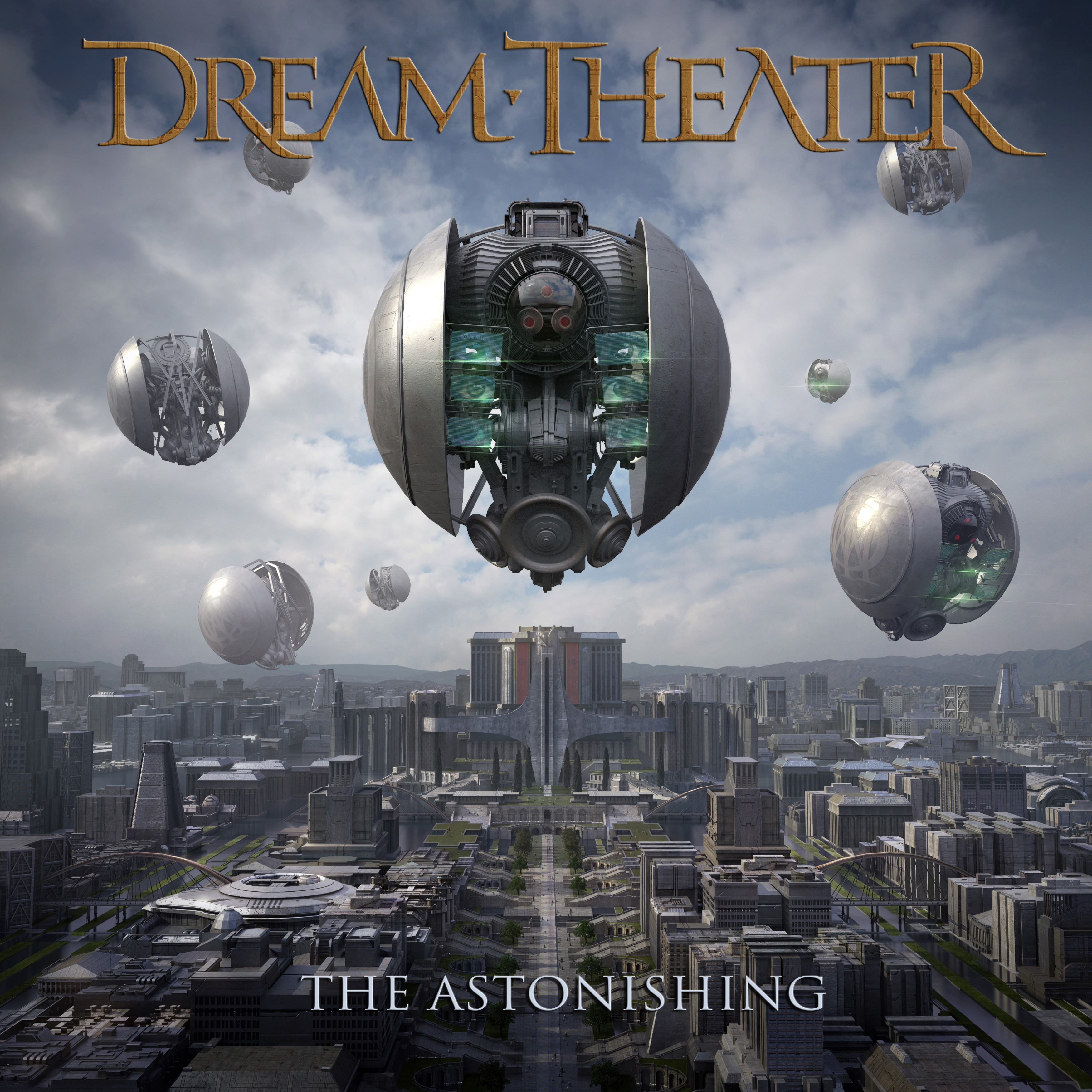 Chester captured the orchestra with a standard Decca tree above the conductor and a pair of “outrigger” mics 10 feet in either direction. All were Neumann TLM 170s.
Chester captured the orchestra with a standard Decca tree above the conductor and a pair of “outrigger” mics 10 feet in either direction. All were Neumann TLM 170s.
An additional 10 close mics (“Close, but not New York close,” he notes) picked up specifics like flutes, oboe and clarinet, with wider room mics for brass. A total of 30 inputs were tracked, with 15 more if strings were doubled.
Chycki provided Chester with Pro Tools sessions featuring stems consisting of drums, bass, guitars, keyboard elements, orchestral mockup and choir mockup. “We usually don’t do it that way,” notes Chester, “unless it’s really, really big. But these sessions were so big, because they had all of the band’s rhythm section on them, times 26 songs. So there was a lot of material going, and a whole lot coming back, maybe 80 GB.”
A similar approach was set up in Los Angeles for the choir and additional elements, such as bagpipes, children’s choir and string solo sections. Working at NRG Recording Studios in North Hollywood, with Schuppan engineering.
By the time all things were said and done, some recordings topped out with as many as 300 or 400 orchestral tracks, with an additional 130 tracks of choir. “Some of them were just massive,” says Chycki. “We’d open up a session, and half of it wouldn’t play back in Pro Tools because it exceeded the track count.” Adds Schuppan, “I counted one day—one session was 286 tracks, and that was just from us.”
Astonishing Vocals
As mentioned, James Labrie’s vocals were the last elements to be recorded, and the lyrics were the last thing to be written. Petrucci was, in some respects, in new territory, writing lyrics drawn from his story. “As a lyricist, there is a lot of storytelling going on. But, at the same time, this is an album. It’s a rock band. They have to exist as songs. The words can’t sound too practical. So I had to make sure there were real releases, real choruses, real thematic, lyrical phrases that would make them sound like songs—like Dream Theater songs.”
After spending time on the road, back at the hotel room after shows, learning the intricate melodies and lyrics, it was time to record. So Labrie and Chycki retreated to a familiar, comfortable location: Chycki’s Street of Dreams home studio in Toronto.
The vocals were recorded using a pair of mics: a Mojave MA-1000 and a Blue Blueberry that Labrie owned. The signal was fed to a Manley Labs Force preamp, then an Inward Connections TSL-3 compressor before hitting Pro Tools.
Mixing Massive Tracks
As one might imagine, mixing the album was no small task. It took Chycki a total of 51 days, a little over eight weeks, working at Germano Studios in New York City, where he had mixed the previous Dream Theater album.
Chycki made ample use of the Studio 2 control room’s SSL Duality desk, particularly letting the console’s onboard EQ and compression do much of the heavy lifting. With a massive number of tracks—577 at its widest—three Pro Tools rigs had to be locked together, with the album on one, vocals/effects on another and the orchestration on the third.
“The Duality peaks out at 96 inputs, so the console was pretty much full all the time,” Chycki says. “The Duality has the ability to act as a Pro Tools controller, but I just used it as a conventional mixer, taking all of the analog outputs from the three Pro Tools systems into the desk,” using classic SSL automation with faders, throws and mutes.
Among his favorite plug-ins and processors, Chycki used a pair of McDSPs, the SA-2 Dialogue Processor for de-essing Labrie’s vocals, and the AE400 Active EQ. “James would be changing the distance he was singing into the microphone a lot,” he explains. “We’d do a very loud piece, so he’d be right up on the mic, and then all of a sudden there would be a buildup of about 200 Hz. The AE400 was fantastic because it would just poke in when needed and pull down the 200 Hz in his vocal and clean it up. That’s been a secret weapon.”
The vocal, as well as the snare drums, also received treatment using Brainworx Stereomaker. “It’s an absolutely stunning plugin,” Chycki says. “It makes James’ vocal wider, but it doesn’t sound processed. So that was a great discovery.”
When mixing the orchestra, Chycki was keen to have Rudess’ original synth mockups handy and easily accessed for reference. “I would turn off the band rig and then open up the orchestration rig and go, ‘Okay, let’s see what they’re doing.’ Then, after some back and forth with Jordan, I would just go in and automate the mix so the orchestra was breathing.”
The project was completed on December 4, 2015, after 10 months, with just a small amount of editing to allow the entire project to fit onto a pair of CDs. “That’s when I actually turned off the espresso machine,” laughs Chycki. “It had a fairly big budget, but that wasn’t really an issue here. They wanted to do something big, bold and different. It takes guts to follow through and do something like that, and say, ‘I want to be the white shirt in a room full of red shirts.”
“My aim, as a writer was to show how special and how important music is in my life and in all our lives,” Petrucci concludes. “I took it to a fantasy level, where it has magical power, but the magic of human expression, whether by voice or musical instrument, how powerful that is. That’s the message.”
